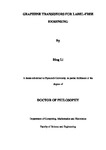GRAPHENE TRANSISTORS FOR LABEL-FREE BIOSENSING
| dc.contributor.supervisor | Pan, Genhua | |
| dc.contributor.author | Li, Bing | |
| dc.contributor.other | School of Engineering, Computing and Mathematics | en_US |
| dc.date.accessioned | 2016-08-12T13:05:17Z | |
| dc.date.available | 2016-08-12T13:05:17Z | |
| dc.date.issued | 2016 | |
| dc.date.issued | 2016 | |
| dc.identifier | 10395688 | en_US |
| dc.identifier.uri | http://hdl.handle.net/10026.1/5291 | |
| dc.description | Full version unavailable due to 3rd party copyright restrictions | |
| dc.description.abstract |
The discovery of monolayer graphene by Manchester group has led to intensive research into a variety of applications across different disciplines. As a monolayer of carbon atoms, graphene presents a high surface to volume ratio and a good electronic conductivity, making it sensitive to its surface bio-chemical environment. This project investigated the fabrication of electronic biosensors using different graphene-based materials. It included the production of graphene, the fabrication of electronic devices, the chemical functionalisation of graphene surface and the specific detection of target bio-molecules. This project first investigated the production of graphene using three different methods, namely mechanical exfoliation, physical vapour deposition and electrochemical reduction of graphene oxide. With respect to the physical vapour deposition method, the production of large area transfer-free graphene from sputtered carbon and metal layers on SiO2 substrate has, for the first time, been achieved. The relationship between growth parameters and the quality of resultant graphene layer has been systematically studied. In addition, a growth model based on the detailed analysis of morphological structures and properties of graphene film was simultaneously proposed. Optical microscopy, Raman spectroscopy and atomic force microscopy were used for the evaluation of the number, the quality and the morphology of resultant graphene layers in each method. To investigate the performance of graphene electronic devices, field effect transistors were fabricated using both exfoliated and chemical vapour deposited graphene. A novel technique for graphene patterning has been developed using deep ultraviolet baking and an improved photolithography method. A new shielding technique for the low damage deposition of Au electrodes on graphene has also been developed in this project. The practical challenges of device fabrication and performance optimisation, such as polymer residue and contact formation, have been studied using Raman spectroscopy and the Keithley 2602A multichannel source meter. For the functionalisation of graphene, a number of chemicals were investigated to provide linking groups that enable binding of bio-probes on the graphene surface. Hydrogen peroxide and potassium permanganate have been demonstrated to have the capability of immobilising oxygen-containing groups onto graphene. The levels of oxidation were estimated by energy dispersive analysis and Fourier transform infrared spectroscopy. In addition, aminopropyltriethoxysilanes and polyallylamine have exhibited good efficiency for immobilising amino groups onto graphene. The resultant graphene was characterised by X-ray photoelectron spectroscopy and cyclic voltammetry measurements. Graphene electrodes modified with electrochemically reduced graphene oxide were developed for the first time which exhibit significantly improved redox currents in electrochemical measurements. Using single stranded DNA immobilised via π-π bonds as probes, these electrodes showed a limit of detection of 1.58 x 10-13 M for the human immunodeficiency virus 1 gene. In parallel, human chorionic gonadotropin sensors were developed by immobilising its antibodies on 1-pyrenebutyric acid N-hydroxysuccinimide ester functionalised graphene field effect transistors. These field effect transistors have been demonstrated to exhibit a quantitative response toward the detection of 0.625 ng/ml antigen. In summary, the fabrications of two types of graphene-based biosensors for the detection of specific DNA sequence and human chorionic gonadotropin have been achieved in this project. Their sensitivity, selectivity, reproducibility and capability of multiple biomarker detection need to be further improved and explored in future work. The outcomes of this project have provided not only ready-made biosensing platforms for the detection beyond these two targets, but also novel techniques applicable to the development of multidisciplinary applications beyond biosensor itself. | en_US |
| dc.language.iso | en | en_US |
| dc.publisher | Plymouth University | en_US |
| dc.subject | Graphene Biosensor | en_US |
| dc.title | GRAPHENE TRANSISTORS FOR LABEL-FREE BIOSENSING | en_US |
| dc.type | Thesis | |
| plymouth.version | Edited version | en_US |
| dc.identifier.doi | http://dx.doi.org/10.24382/4558 |
Files in this item
This item appears in the following Collection(s)
-
01 Research Theses Main Collection
Research Theses Main


